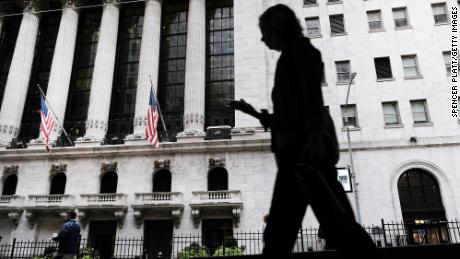Fed Chair Jerome Powell sounds more hawkish. This strategist explains why
New York (CNN Business)Last week’s stock market selloff seems like ancient history. Stocks surged Monday and Tuesday and were flat to modestly higher early Wednesday as investors once again buy the proverbial dip.
Buying the dip is basically a phrase investors use when they are purchasing a stock after a big drop because they think it will quickly bounce back. Forget about Dow 36,000 t-shirts. Baseball caps with the “BTFD” acronym are likely more popular on Wall Street these days. (You can probably guess what the “F” stands for. If not, Google it.)
The problem is that volatility has clearly returned to the market. The VIX (VIX), a volatility measure often referred to as Wall Street’s fear gauge, is up nearly 35% in the past month — and that includes a 20% drop Tuesday.
The CNN Business Fear & Greed Index, which looks at the VIX and six other indicators of market sentiment, has swung wildly as of late, too. It’s currently showing signs of Fear and was in Extreme Fear territory Monday. But just a month ago, the index was at Extreme Greed levels.
“This is still an extremely fragile market,” Craig Erlam, a senior market analyst with Oanda, a foreign exchange broker, said in a report. The risk that investors face is that it’s a challenging time to predict how low an asset price will go.
“Time will tell whether investors are getting ahead of themselves, but a couple of days without a negative Omicron headline has the dip buyers flooding back in,” Erlam added.
The news from Pfizer (PFE) and its partner BioNTech (BNTX) that three doses of their Covid-19 vaccine can “neutralize” the Omicron variant may help boost sentiment even further.
Omicron worries may fade but inflation isn’t going away
Although the dizzying gyrations in stocks may be alarming to some, one expert noted that it’s only natural for investors to react dramatically to the quickly shifting Omicron headlines.
“In theory, such strong gains are a sign of instability and should be taken with caution,” Ipek Ozkardeskaya, senior analyst with Swissquote, said in a report Wednesday. “However the good news is that … the latest fears could slowly begin fading.”
Of course, the other big worry for investors besides Omicron hasn’t gone away.
Inflation concerns may come roaring back as soon as Friday. That’s when the US government is set to report its latest data on consumer prices. Prices were up 6.2% annually in October, the biggest spike in 30 years.
Higher prices are likely to remain the major focus for investors in 2022, especially if the job market continues to remain strong — which would put added pressure on wages. That could lead the Federal Reserve to raise interest rates more quickly than currently expected.
“We will perhaps still see some occasional bouts of volatility from Covid … and some slowdowns here and there, but overall, it will not be the major driver for markets in 2022,” analysts at Robeco said in a report Wednesday. “Over the next year, the focus on labor markets will be a bigger driver of central bank action, at least in developed economies.”
Source: Read Full Article



